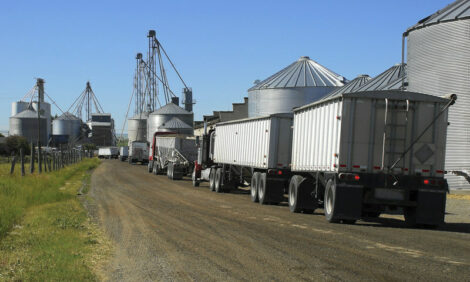



China Hog Markets – June 2011
CHINA - China is the pork powerhouse of the world with over 51 per cent of the world’s population of pigs being raised within China, writes Ron Lane, Senior Consultant for Genesus in China.Looking at the size of the breakdown of the inventory for March 2011—breeding stock was around 47.3 million and total on farm inventory was about 444 million head (as compared to 46.6 million sows and total on farm inventory about 455 million head in November 2010).
Sow inventory reached 47.3 million head in March, down 0.2 per cent from February and down 3.3 per cent compared to one year ago. Sow inventory had increased in September, but decreased through October and November, a marginal increase in December and then slightly lower in January 2011. For March, sow inventory was 10.65 per cent of the live hog inventory and this is the same as February 2011.
Average live hog prices in March (the price reaching just over 15.06RMB/kg. liveweight- approx. $2.32 US/kg. liveweight) were up from February (the average price reaching 14.83 RMB/kg. liveweight (approx. $2.28 US/kg. liveweight). The average monthly live hog price in Central China declined, while other regions in China showed a slight increase. The decrease of prices in the Central regions was the negative affect of Clenbuterol found in pigs in the Central region slaughterhouse owned by Shuanghui (Shineway Meats). Throughout the month of March, the price decreased with a drop from 15.13 RMB/kg in the beginning of the month to 15.05 RMB/kg by the end. Live hog price over the next few months is expected to be steady with a little decline.
Profit margins continue to show strength. During the spring 2010, there were losses for most large-scale farms. With increasing market price, the profit margins have gained significantly (100 RMB/market pig for July 2010-$14.90 US; 140 RMB/market pig for September 2010-$20.90 US; and 260 RMB/market pig for November 2010-$39.03 US. March, 2011 again shows an increase in profit margins to 325 RMB/market pig -$50.00 US. This was a substantial increase from February when the profit margins were closer to 304 RMB/market pig- $46.27 US.
The March average profits for those who purchased piglets from the market gained 318.0 RMB/head-$ 48.92 US, up 37.0 RMB/head-$ 5.69 US from February. The national piglet prices averaged 25.20 RMB/kg-$ 3.76 US/kg.in March, up 3.20 RMB/kg.-$ .49 US/kg. from February.
Short term scenario: Farmers’ have high expectations that the market price will increase through the spring and into the mid-summer (throughout 2010, the inventory of live hog and fertile sows declined and now overall supply is tight-disease played a major role in 2010 as "summer fever" caused death, reduced fertility and caused lower piglet survivability). Following the concentrated slaughtering before Spring Festival, February and March are the traditional inventory peak periods. Millions of small farmers will actively restock and thus piglet demand will also increase. Current piglets’ pricing indicates that there are fewer piglets for restocking. That is why the piglets’ price averaged 25.2 RMB/kg-$ 3.88 US in March (compared to 23.8/kg-$ 3.62 US/kg. in February and up RMB 3.80/kg-$0.58 US/kg. or 20 per cent from before Spring Festival. Right now the farmers are continuing to source scarce piglets.
What to watch for over the next few months!!!
- The pig and grain (corn) ratio in December was at the profitable level of 6.7:1. In February, the pig and corn ratio was 7.12:1 and was 7.07:1 for March. Currently, the ratio is 7.63:1. With continued Government incentives and "good profit margins", pig expansion in China will continue.
- In February, China imported fresh and frozen pork 11,900 MT, down 58.5 per cent from last month, but up 60 per cent year on year. From January to February, China accumulatively imported 40,600 MT of pork, up 78.3 per cent year on year; among which 18,700 MT was from America, accounting for 46.0 per cent of the total; 8,100 MT from Canada, up 84.2 per cent year on year, accounting for 20.1 per cent of the total and with Denmark (4,838 MT), France (3,046 MT) and Spain (3,155 MT) being the other major exporters to China. Will this trend continue or will Brazil become a major exporter into China? In early April, China authorized three Brazilian pork producers for the first time to export pork into China. The Brazilian export association (Abipecs) considers the Chinese market could take about 200,000 tonnes/year. First shipments could occur in the fourth quarter of this year.-As of the week-ending April 28, US soybean commitments (outstanding sales plus accumulated exports) to China was about 25.6 million tons, compared to 21.9 million a year ago. Total commitments to the world are 41.1 million tons compared to 37.4 million for the same period last year. For the 2100/2012 trade outlook: ( Oilseeds, May 2011)
- US soybean exports are forecast at 41.9 million tons, reflecting strong competition from South America. The projected smaller crop could limit exportable supplies.
- Brazil’s soybean exports are forecast at a record 33.5 million tons on an expected larger crop.
- Argentina’s soybean exports are forecast at 11.8 million tons, sharply up from the current year, based on an expected near record crop.
- China’s soybean imports are forecast at a record 58 million tons as strong demand for crush continues. Already, in January, China signed a $6.68 US billion soybean sale for about 11.7 million tons (10.62 million MT) with the USA. From this, the US Department of Agriculture in their 24 February Agricultural Trade Outlook, are projecting $20 billion in soybean sales to China in fiscal year 2011.
- Fu Bingtao, an economist with the Agricultural Bank of China-ABC-in Beijing, reports that the price of grains that are closely linked to the price of food, would rise by 10 per cent in 2011. This is on top of the 11.7 per cent rise of grains in 2010. The danger is that higher food prices along with increased inflation pressures will cause concern with the Government. The People’s Bank of China raised interest rates for the 4th time in six months on 5 April. Consumer prices had climbed 5.2 per cent in March from one year previous. Of this, food inflation reached 11 per cent in February. The Government goal is 4 per cent. Again, a balancing act between grain for food and/or livestock; imports of pork versus domestic production and pricing and response to inflation data.
- It is estimated that the average Chinese citizen will consume 39.3 kilograms (86.6 pounds of pork this year). This compares to the 19.7 kilograms (43.4 pounds) in 1990 (USDA data). The Chinese like pork—would it not be grand, if we could achieve the same consumption results in North America?
- Clenbuterol. Originally, it was banned for use with swine in 2002. However, it is still in use, illegally. There were about 18 reported cases of food-related clenbuterol poisoning between 1998 and 2007 (Shanghai Food Safety website). However, on 15 March, China’s largest meat producer, Shuanghui (Shineway Meats) sold pork that contained clenbuterol.
- The illegal use of Clenbuterol had a limited effect on current live hog market prices, but its use will have a long term effect on food safety measures. The influence would be mainly as follows:
- Government departments at all levels will continue to encourage and improve standardized and large-scale farming of the hog industry and that the proportion of live hog standardized and scaled farming will greatly increase. Live hog integrated farming level will be enhanced. Slaughter enterprises will especially strengthen their control on the source of live hogs and thus, they will accelerate steps towards their own or controlled hog farming industry.
- Quality tracing system of livestock and poultry products will be soon put into place. Already, in 2011, the Ministry of Commerce (in charge of slaughterhouse regulations) decided to add another 10 cities on the basis of the first group of pilot cities and to further develop pork and vegetable quality tracing systems.
- The consuming preference situation on lean meat will continue to change. After the Clenbuterol instance happened, sales volume and sales price of domestic lean, hybrid pigs both increased. This encourages the sale of quality breeding stock from within China and for foreign swine breeding companies.
- Government departments at all levels will continue to encourage and improve standardized and large-scale farming of the hog industry and that the proportion of live hog standardized and scaled farming will greatly increase. Live hog integrated farming level will be enhanced. Slaughter enterprises will especially strengthen their control on the source of live hogs and thus, they will accelerate steps towards their own or controlled hog farming industry.









